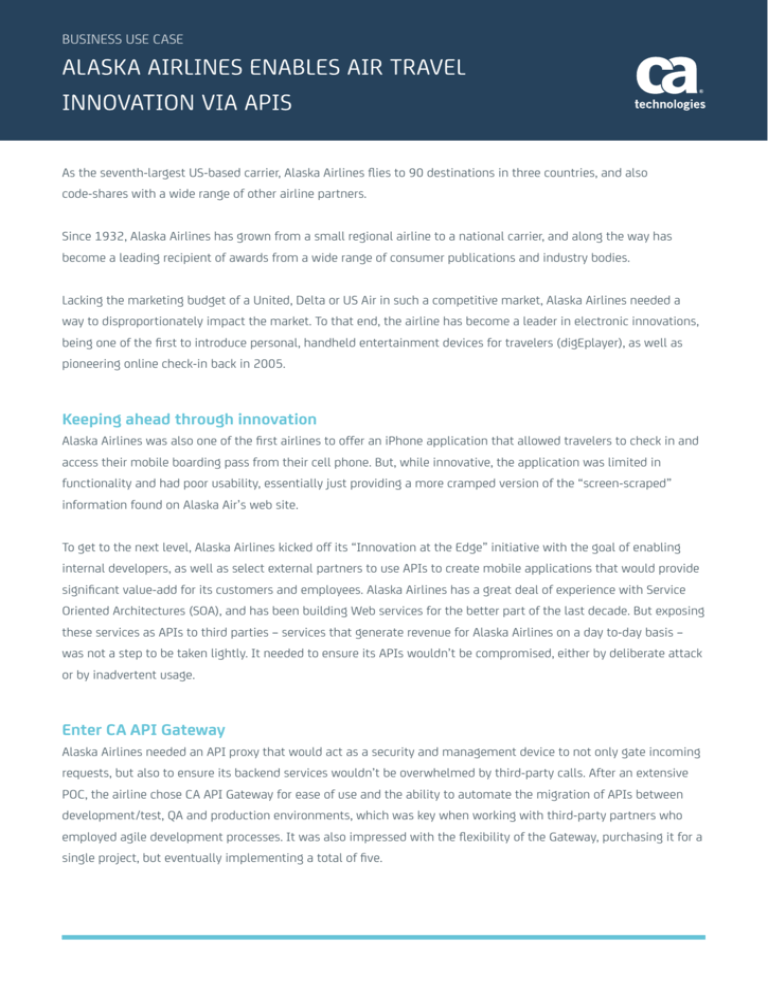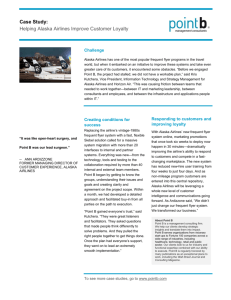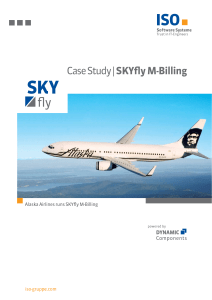Read Case Study - CA Technologies
advertisement

BUSINESS USE CASE As the seventh-largest US-based carrier, Alaska Airlines flies to 90 destinations in three countries, and also code-shares with a wide range of other airline partners. Since 1932, Alaska Airlines has grown from a small regional airline to a national carrier, and along the way has become a leading recipient of awards from a wide range of consumer publications and industry bodies. Lacking the marketing budget of a United, Delta or US Air in such a competitive market, Alaska Airlines needed a way to disproportionately impact the market. To that end, the airline has become a leader in electronic innovations, being one of the first to introduce personal, handheld entertainment devices for travelers (digEplayer), as well as pioneering online check-in back in 2005. Keeping ahead through innovation Alaska Airlines was also one of the first airlines to offer an iPhone application that allowed travelers to check in and access their mobile boarding pass from their cell phone. But, while innovative, the application was limited in functionality and had poor usability, essentially just providing a more cramped version of the “screen-scraped” information found on Alaska Air’s web site. To get to the next level, Alaska Airlines kicked off its “Innovation at the Edge” initiative with the goal of enabling internal developers, as well as select external partners to use APIs to create mobile applications that would provide significant value-add for its customers and employees. Alaska Airlines has a great deal of experience with Service Oriented Architectures (SOA), and has been building Web services for the better part of the last decade. But exposing these services as APIs to third parties – services that generate revenue for Alaska Airlines on a day to-day basis – was not a step to be taken lightly. It needed to ensure its APIs wouldn’t be compromised, either by deliberate attack or by inadvertent usage. Enter CA API Gateway Alaska Airlines needed an API proxy that would act as a security and management device to not only gate incoming requests, but also to ensure its backend services wouldn’t be overwhelmed by third-party calls. After an extensive POC, the airline chose CA API Gateway for ease of use and the ability to automate the migration of APIs between development/test, QA and production environments, which was key when working with third-party partners who employed agile development processes. It was also impressed with the flexibility of the Gateway, purchasing it for a single project, but eventually implementing a total of five. Alaska Airlines needed an API proxy that would act as a security and management device to not only gate incoming requests, but also to ensure its backend services wouldn’t be overwhelmed by third-party calls. After an extensive POC, the airline chose CA API Gateway for ease of use and the ability to automate the migration of APIs between development/test, QA and production environments, which was key when working with third-party partners who employed agile development processes. It was also impressed with the flexibility of the Gateway, purchasing it for a single project, but eventually implementing a total of five. Keeping ahead through innovation In August 2011, travelers began downloading the updated Alaska Airlines app. The redesigned application takes advantage of the new API-based approach, delivering a Web 2.0 look and feel that streamlines how travelers check in and access their mobile boarding pass, get flight status/details; select/change seats; and track their mileage plan. When a traveler uses the application, they’re prompted to log in to their Alaska Airlines account. The CA API Gateway performs authentication and authorization against the local LDAP, and routes the request to the appropriate service while recording the hit against the API so Alaska Airlines can track usage to determine which applications are most popular, and which APIs should be invested in going forward. If the request requires flight information, the service employs the CA API Gateway to query internal flight status services and cache the results so that future requests can minimize response time and decrease costs associated with querying backend systems. This new approach has allowed Alaska Airlines employees and partners to quickly create other innovative applications that work in a similar way to the mobile application, including: •FlyingSocialTM with Alaska Airlines – Facebook users can directly access Alaska Airlines travel offers • Alaska Mobile Track – Alaska Air Cargo customers can send a text message of their shipping number and receive a reply that shows where their package is en route • Baggage Handling – Ground crews can better expedite the loading and unloading of baggage from flights, decreasing baggage handling times and speeding travelers on their way Saving time and money With the CA API Gateway in place, Alaska Airlines can now securely expose its APIs to potentially thousands of third-party developers whose applications are dramatically expanding its market reach. The Gateway tracks API usage by application, facilitating the understanding of where to invest going forward. And by caching results for travelers’ flight information, Alaska Airlines can reduce its backend network costs. The API-based approach has already proven itself, fostering innovative applications that get to market sooner than traditional approaches, thereby giving Alaska Airlines a leg up on the competition in the US air travel market. This document describes a project undertaken between Layer 7 Technologies and Alaska Airlines in 2011, prior to the acquisition of Layer 7 Technologies by CA Technologies









